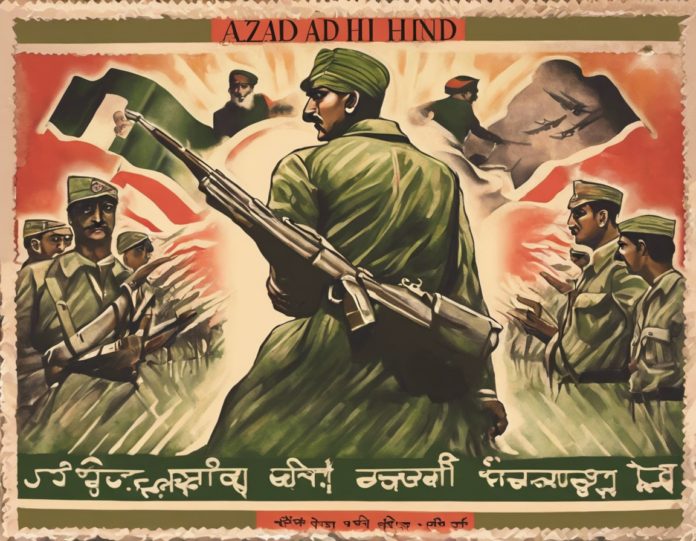Introduction
The Azad Hind Fauj, also known as the Indian National Army (INA), was a revolutionary military force formed during World War II with the aim of liberating India from British colonial rule. Led by the iconic nationalist leader Subhas Chandra Bose, the Azad Hind Fauj played a crucial role in the freedom struggle of India and left a lasting legacy that continues to inspire generations.
The Formation of Azad Hind Fauj
The Azad Hind Fauj was formed on October 21, 1942, in Southeast Asia with the support of the Japanese during their occupation of parts of British-controlled territories. Subhas Chandra Bose, who had escaped house arrest in India, took a submarine to Japan and subsequently traveled to Southeast Asia to lead the force. His rallying cry, "Give me blood, and I shall give you freedom," resonated with many Indians who were disillusioned with British rule.
Objectives of Azad Hind Fauj
The primary objective of the Azad Hind Fauj was to overthrow British colonial rule in India and establish a free and independent nation. Subhas Chandra Bose saw the opportunity to leverage the assistance of Axis powers, primarily the Japanese, to achieve this goal. While controversial, his alliance with the Japanese was a strategic move to weaken the British hold on India.
Military Campaigns
The Azad Hind Fauj undertook military campaigns in Southeast Asia, particularly in Burma (now Myanmar), with the aim of advancing towards India. The force participated in key battles against the British Indian Army, most notably during the Burma Campaign. Despite facing logistical challenges and being outnumbered, the Azad Hind Fauj showcased remarkable resilience and determination in the face of adversity.
Rani of Jhansi Regiment
One of the noteworthy aspects of the Azad Hind Fauj was the formation of the Rani of Jhansi Regiment, an all-women unit named after the iconic freedom fighter Rani Lakshmibai. These brave women played a pivotal role in various support tasks, nursing wounded soldiers, and demonstrating their unwavering commitment to the cause of Indian independence.
Impact and Legacy
While the Azad Hind Fauj did not achieve its immediate military objectives, its legacy was profound and far-reaching. The formation of a unified force representing the aspirations of a free India sent a powerful message to the British colonial rulers. The courage and sacrifice of the soldiers of the Azad Hind Fauj inspired millions of Indians to continue the fight for independence.
Subhas Chandra Bose: The Hero of Azad Hind Fauj
Subhas Chandra Bose, fondly known as Netaji, emerged as a charismatic leader who galvanized the masses with his vision of a free India. His leadership of the Azad Hind Fauj earned him legendary status, and his daring escape from India to lead the force remains a captivating chapter in the annals of Indian history. Bose's unwavering commitment to the cause of independence and his belief in the power of the people to bring about change continue to inspire generations of Indians.
The INA Trials
After the end of World War II and the defeat of the Axis powers, the members of the Azad Hind Fauj, including Subhas Chandra Bose, faced trials by the British authorities. The famous INA trials, held at the Red Fort in Delhi, became a turning point in the freedom struggle. The public outcry and support for the soldiers of the Azad Hind Fauj forced the British to rethink their strategy in holding the trials, leading to a wave of discontent that hastened India's independence.
Remembering the Heroes
The sacrifices of the soldiers of the Azad Hind Fauj and their unwavering commitment to the cause of freedom should never be forgotten. Their courage in the face of adversity and their belief in a free and independent India serve as a reminder of the power of unity and determination in the pursuit of justice and liberty.
Frequently Asked Questions (FAQs)
- What was the main goal of the Azad Hind Fauj?
-
The main goal of the Azad Hind Fauj was to liberate India from British colonial rule and establish an independent nation.
-
Who was the leader of the Azad Hind Fauj?
-
The Azad Hind Fauj was led by Subhas Chandra Bose, a prominent nationalist leader who played a significant role in the freedom struggle of India.
-
What was the Rani of Jhansi Regiment?
-
The Rani of Jhansi Regiment was an all-women unit within the Azad Hind Fauj, named after the legendary freedom fighter Rani Lakshmibai.
-
What legacy did the Azad Hind Fauj leave behind?
-
The Azad Hind Fauj left behind a legacy of courage, sacrifice, and determination in the fight for Indian independence, inspiring future generations to continue the struggle for freedom.
-
How did the INA trials impact India's independence movement?
- The INA trials became a rallying point for the freedom movement in India, galvanizing public support and creating a wave of discontent that hastened India's independence from British colonial rule.
In conclusion, the Azad Hind Fauj, under the leadership of Subhas Chandra Bose, remains a symbol of courage and resilience in the fight for freedom. The legacy of the force continues to resonate with Indians, reminding them of the sacrifices made by those who dared to dream of a free and independent India.

